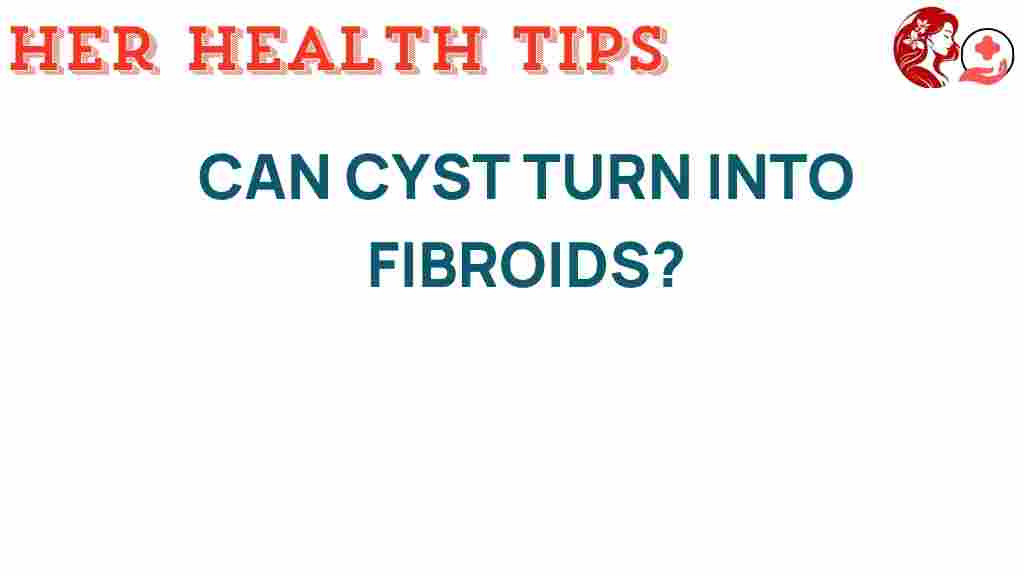Are Cysts a Gateway to Fibroids? Understanding Cysts, Fibroids, and Women’s Health
In the realm of women’s health, understanding various gynecological conditions is essential for maintaining optimal reproductive health. Among these conditions, cysts and fibroids are commonly discussed, yet many women are unsure about their relationship. Are cysts a gateway to fibroids? This article unravels the mystery surrounding these two conditions, exploring their implications on hormonal balance, risk factors, diagnosis, and treatment options.
Understanding Cysts
Cysts are fluid-filled sacs that can develop in various parts of the body, including the ovaries. In the context of women’s health, ovarian cysts are particularly significant. Most ovarian cysts are benign and often resolve on their own. However, they can cause discomfort and may lead to complications if left untreated.
- Types of Ovarian Cysts:
- Functional Cysts
- Dermoid Cysts
- Cystadenomas
- Endometriomas
- Symptoms of Ovarian Cysts:
- Pelvic pain
- Menstrual irregularities
- Pressure symptoms
Understanding Fibroids
Fibroids, or uterine leiomyomas, are non-cancerous growths of the uterus that often appear during childbearing years. They can vary in size and number, affecting a woman’s health significantly.
- Types of Fibroids:
- Intramural Fibroids
- Subserosal Fibroids
- Submucosal Fibroids
- Pedunculated Fibroids
- Symptoms of Fibroids:
- Heavy menstrual bleeding
- Pelvic pressure or pain
- Frequent urination
- Difficulty emptying the bladder
Are Cysts a Gateway to Fibroids?
The question arises: can the presence of cysts lead to the development of fibroids? While both conditions are related to hormonal balance and can affect a woman’s reproductive health, they are distinct entities. Understanding their connection requires examining the factors that influence their growth.
Hormonal Balance and Its Role
Hormones play a crucial role in both the formation of cysts and fibroids. Estrogen and progesterone are the primary hormones involved:
- **Estrogen:** High levels can stimulate the growth of both cysts and fibroids.
- **Progesterone:** Imbalances can also contribute to the development of these conditions.
Therefore, hormonal imbalances could potentially lead to the development of both cysts and fibroids, suggesting a possible link between the two. However, it is essential to note that having cysts does not directly cause fibroids.
Diagnosis of Cysts and Fibroids
Diagnosing cysts and fibroids typically involves a combination of medical history, physical examination, and imaging studies. Common diagnostic methods include:
- Ultrasound: The most common imaging technique for visualizing ovarian cysts and fibroids.
- MRI: Provides detailed images to distinguish between cysts and fibroids.
- CT Scans: Occasionally used for further evaluation.
Early diagnosis is key in managing both conditions effectively. Regular pelvic exams can help detect any abnormalities early on. For more information on diagnosis and management, visit this resource.
Treatment Options for Cysts and Fibroids
When it comes to treatment, the approach may vary based on the severity of symptoms and the specific characteristics of the cysts or fibroids. Here are some common treatment options:
- Watchful Waiting: Many cysts resolve on their own and may not require treatment.
- Medications: Hormonal contraceptives can help regulate menstrual cycles and control symptoms.
- Surgery: In cases where cysts or fibroids cause significant pain or complications, surgical options may be considered.
Risk Factors Associated with Cysts and Fibroids
Several risk factors can contribute to the development of cysts and fibroids:
- Age: Women in their reproductive years are more likely to develop both conditions.
- Family History: A family history of fibroids may increase the likelihood of developing them.
- Obesity: Excess body weight is linked to higher estrogen levels, which may contribute to the growth of fibroids.
- Hormonal Factors: Conditions that lead to hormonal imbalances can increase the risk of both cysts and fibroids.
Step-by-Step Process for Managing Cysts and Fibroids
Managing cysts and fibroids involves a systematic approach:
- Regular Check-ups: Schedule regular gynecological check-ups to monitor reproductive health.
- Seek Medical Advice: If you experience symptoms, consult a healthcare provider for proper diagnosis.
- Understand Treatment Options: Discuss with your doctor the best treatment options based on your condition.
- Monitor Symptoms: Keep track of any changes in your symptoms and communicate with your healthcare provider.
- Maintain a Healthy Lifestyle: Focus on a balanced diet, regular exercise, and weight management to support hormonal balance.
Troubleshooting Tips for Managing Symptoms
Here are some tips for managing symptoms related to cysts and fibroids:
- Heat Therapy: Applying heat to the pelvic area can alleviate cramping and discomfort.
- Pain Management: Over-the-counter pain relief medications can help manage mild pain.
- Dietary Adjustments: Incorporating anti-inflammatory foods may help reduce symptoms.
- Stay Hydrated: Proper hydration can help ease discomfort and improve overall health.
Conclusion
In conclusion, while cysts and fibroids are both significant gynecological conditions that can impact women’s health, they are not directly linked as causes of one another. Hormonal balance plays a crucial role in their development, and understanding the risk factors is essential for effective management. Regular check-ups and awareness of symptoms can lead to timely diagnosis and treatment options, ensuring better reproductive health. If you have concerns regarding cysts, fibroids, or any other aspects of your health, it is important to consult a healthcare professional for personalized advice and care.
For more information on women’s health and related conditions, explore this informative article.
This article is in the category Reproductive and created by HerHealthTips Team
